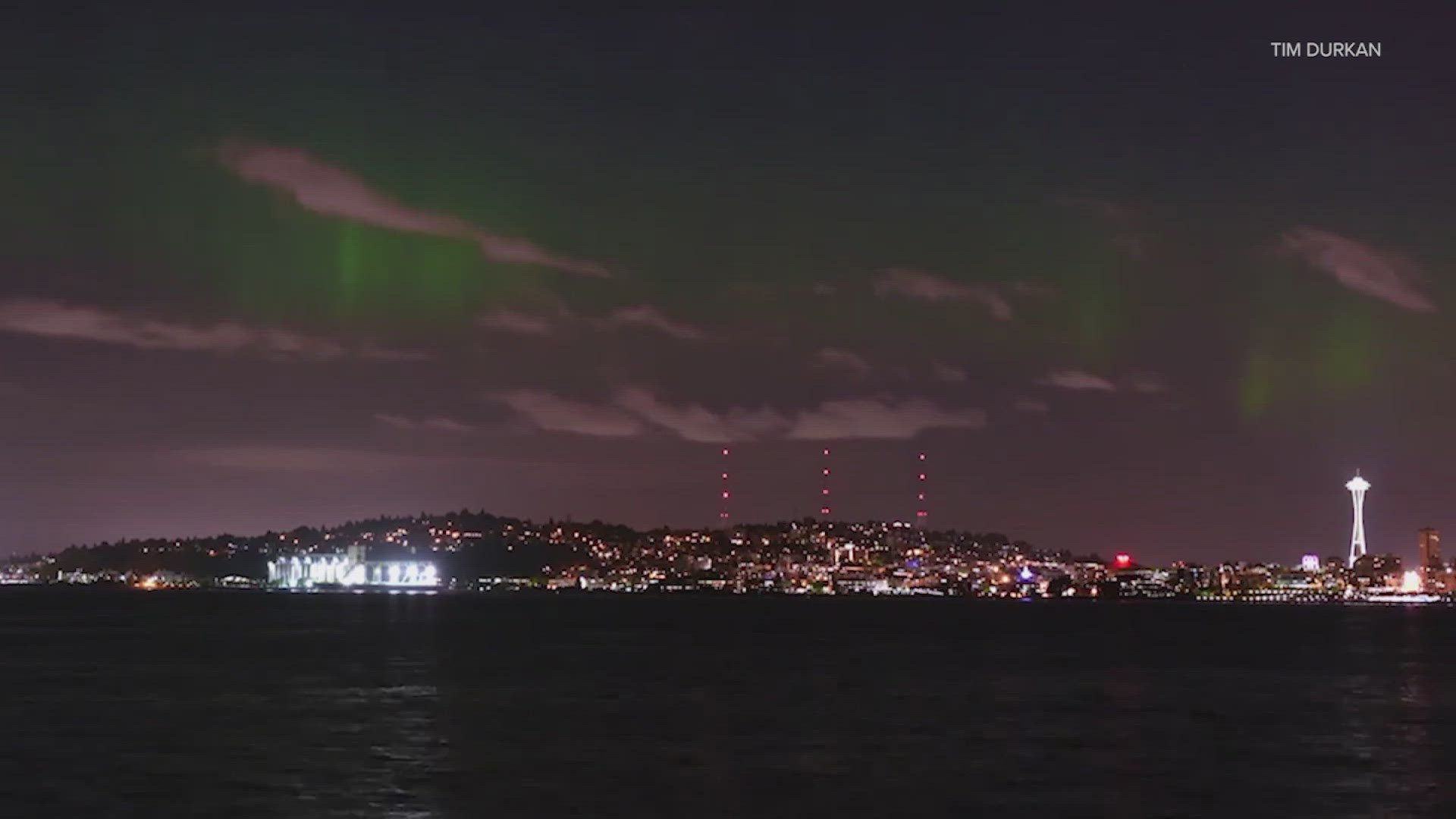SEATTLE — A severe geomagnetic storm could make the Northern Lights, also known as aurora borealis, visible in Washington skies Sunday night, according to the National Oceanic and Atmospheric Administration (NOAA) Space Weather Forecast Center.
But, it depends on the time.
The aurora borealis is a colorful glow in the sky produced when electrons trapped in the Earth’s magnetic field are accelerated by the solar wind and collide with atoms in the atmosphere in a ring centered on the magnetic pole of Earth, according to NOAA.
How does this happen?
NASA says auroras are a result of the effects of solar storms. During coronal mass ejections (CME), a kind of storm, the sun can send electrified gas toward the Earth, delivering energy and small particles down magnetic field lines. Particles can interact with atmospheric gases to produce visuals of light in the sky.
One forecast model shows three CMEs could combine to form a "Cannibal CME." NOAA is predicting the storm on May 11, when the Cannibal arrives.
KING 5 Meteorologist Rich Marriott says the strength of the storm impacts how likely Washington is to see an aurora.
"The stronger the storm, the more it pushes the aurora away from the magnetic poles — further south to where we live," Marriott said. "The farther north you are, the closer you are to the magnetic pole, the more likely you are to see it. Alaska is very close to the magnetic pole, that's why they see aurora all the time."
So, will I be able to see Northern Lights in Washington?
Aurora borealis may be visible over Washington on Sunday. According to KING 5's Rich Marriott, unlike an eclipse, the exact time an aurora will occur isn't predictable. Friday and Saturday night delivered stunning views with peak times into the early morning hours.
The storm will continue Sunday and is expected to be on par with Saturday night but weaker than Friday. NOAA Space Weather Prediction Center expects severe (G4) conditions to continue through the weekend.
For those who want to see the aurora borealis, it's important to get far away from city light pollution. It's also best to have a clear view of the northern horizon.
"To see those emerald green lights dancing in the sky, it's life-changing, it's amazing to see," Photographer Tim Durkan said. "Once you see them, it's like an eclipse- you have to keep going back over and over again, so I'm very excited about tonight."
His advice for first-timers hoping to snap a photo is to use a tripod and shutter release for minimal shaking or movement of the camera. He says in areas with a lot of light pollution, the lights may appear more white, but will show up more green on camera.
He encourages people to take time to enjoy the moment.
"There's two things I love to do with Northern lights- get the photo, of course, but its also a moment to just commune with nature," Durkan said. "You take five minutes to see something, and imagine what they thought 500, 1,000 years ago when they saw this event going on."
Durkan posts the photos he takes on his Instagram.
How the aurora borealis is measured: the Kp index
The aurora is measured using the Kp index, which is a scale of 0-9. NOAA’s tips on viewing the aurora share this scale for viewing:
For Kp in the range of 0 to 2, the aurora will be far north, quite dim in intensity, and not very active.
For Kp in the range of 3 to 5, the aurora will move further from the poles. It will become brighter and there will be more auroral activity (motion and formations). If you are in the right place, these aurora can be quite pleasing to look at.
For Kp in the range 6 to 7, the aurora will move even further from the poles and will become quite bright and active. At this geomagnetic activity level, it might be possible to see the aurora from the northern edge of the United States.
For Kp in the range 8 to 9, the aurora will move even further towards the equator and it will become very bright and very active. These are the events that create the best aurora and the extended auroral oval will be observable by most people. At these levels, the aurora may be seen directly overhead from the northern states of the U.S.

